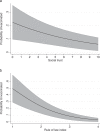Resistance to COVID-19 vaccination and the social contract: evidence from Italy
- PMID: 37087511
- PMCID: PMC10122449
- DOI: 10.1038/s41541-023-00660-8
Resistance to COVID-19 vaccination and the social contract: evidence from Italy
Abstract
Confronted with stalled vaccination efforts against COVID-19, many governments embraced mandates and other measures to incentivize vaccination that excluded the unvaccinated from aspects of social and economic life. Even still, many citizens remained unvaccinated. We advance a social contract framework for understanding who remains unvaccinated and why. We leverage both observational and individual-level survey evidence from Italy to study the relationship between vaccination status and social context, social trust, political partisanship, and adherence to core institutional structures such as the rule of law and collective commitments. We find that attitudes toward the rule of law and collective commitments outside the domain of vaccination are strongly associated with compliance with vaccine mandates and incentives. Partisanship also corresponds with vaccine behaviors, as supporters of parties whose leaders criticized aggressive policies to incentivize or mandate vaccination and emphasized individual liberty are least likely to comply. Our findings suggest appeals emphasizing individual benefits may be more effective than appeals emphasizing collective responsibility.
© 2023. The Author(s).
Conflict of interest statement
The authors declare no competing interests.
Figures




Similar articles
-
Political Partisanship and Trust in Government Predict Popular Support for COVID-19 Vaccine Mandates for Various Professions and Demographic Groups: A Research Note.Am Polit Res. 2023 Mar;51(2):139-146. doi: 10.1177/1532673X221118888. Epub 2022 Aug 9. Am Polit Res. 2023. PMID: 38603210 Free PMC article.
-
Addressing vaccine hesitancy and resistance for COVID-19 vaccines.Int J Nurs Stud. 2022 Jul;131:104241. doi: 10.1016/j.ijnurstu.2022.104241. Epub 2022 Apr 1. Int J Nurs Stud. 2022. PMID: 35489108 Free PMC article. Review.
-
Political Partisanship, Confucian Collectivism, and Public Attitudes toward the Vaccination Policy in Taiwan.J Health Polit Policy Law. 2025 Feb 1;50(1):23-46. doi: 10.1215/03616878-11513094. J Health Polit Policy Law. 2025. PMID: 39118278
-
Political Party Affiliation and COVID-19 Vaccination Status in Japan, 2022.Cureus. 2024 Aug 2;16(8):e66035. doi: 10.7759/cureus.66035. eCollection 2024 Aug. Cureus. 2024. PMID: 39229434 Free PMC article.
-
The vaccine against COVID-19 and institutional trust.Enferm Infecc Microbiol Clin (Engl Ed). 2021 Dec;39(10):510-515. doi: 10.1016/j.eimce.2021.09.001. Epub 2021 Sep 10. Enferm Infecc Microbiol Clin (Engl Ed). 2021. PMID: 34518151 Free PMC article. Review.
Cited by
-
Vaccination decisions and social capital in Japan.SSM Popul Health. 2025 Feb 26;30:101769. doi: 10.1016/j.ssmph.2025.101769. eCollection 2025 Jun. SSM Popul Health. 2025. PMID: 40124530 Free PMC article.
-
Individual predictors of vaccine hesitancy in the Italian post COVID-19 pandemic era.Hum Vaccin Immunother. 2024 Dec 31;20(1):2306677. doi: 10.1080/21645515.2024.2306677. Epub 2024 Jan 30. Hum Vaccin Immunother. 2024. PMID: 38289323 Free PMC article.
-
Temporal changes in factors associated with COVID-19 vaccine hesitancy among Chinese adults: Repeated nationally representative survey.SSM Popul Health. 2023 Dec 10;25:101574. doi: 10.1016/j.ssmph.2023.101574. eCollection 2024 Mar. SSM Popul Health. 2023. PMID: 38273868 Free PMC article.
-
Political context of the European vaccine debate on Twitter.Sci Rep. 2024 Feb 22;14(1):4397. doi: 10.1038/s41598-024-54863-7. Sci Rep. 2024. PMID: 38388713 Free PMC article.
-
Esoteric beliefs and CAM impact SARS-CoV-2 immunization drivers, uptake and pediatric immunization views in Germany.NPJ Vaccines. 2024 Aug 3;9(1):137. doi: 10.1038/s41541-024-00928-7. NPJ Vaccines. 2024. PMID: 39097580 Free PMC article.
References
LinkOut - more resources
Full Text Sources

